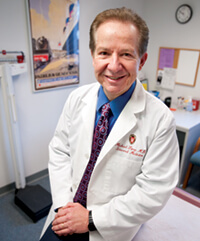Michael Fiore
This anti-smoking advocate believes the battle against tobacco can be won.
On Wisconsin last featured Fiore, director of UW-Madison’s Center for Tobacco Research and Intervention, in Winter 2005, not long after he testified in the federal government’s landmark lawsuit against Big Tobacco. His efforts got another boost last summer, when new legislation gave the U.S. Food and Drug Administration authority to regulate tobacco. More recently, Fiore received a national award for his dedication to patient advocacy, and his center earned a $9 million research grant from the National Cancer Institute to find new ways to help the 20 percent of Americans who still smoke to break free of the addiction.
Q: What’s making it possible to eliminate tobacco use in America?
A: Two things — first, the recognition of tobacco use as a drug of dependence, and second, the recognition that when I smoke in your presence, it’s not just a choice I’m making, but it’s also putting your health in danger. These developments have totally changed the landscape.
Q: You’re concerned about the rate of smoking among veterans. Do they need different support from civilians to quit?
A: We’re investigating that. We have a young investigator [at the veterans hospital] — Jessica Cook — who is looking at post-traumatic stress disorder and smoking, because those two challenges that veterans face really run in parallel. … Rates of smoking among returning Iraq and Afghanistan veterans in some surveys are above 40 percent — double the rate of the general population. That is an enormous legacy: we’re asking these young people to serve our country and risk their lives. They make these sacrifices willingly, then return home addicted to a drug that’s going to kill half of them prematurely.
Q: How can the new grant help tackle the ongoing challenges to helping people quit?
A: Virtually all of the treatments currently available for smokers are for those who are ready to quit that day — and that represents less than half of smokers. Our goal is to evolve a new set of treatments for people who aren’t yet ready to quit, but are willing to take treatment that may motivate them to quit in the future while they continue to smoke.
Q: What will that include?
A: One approach is a new kind of counseling called motivational interviewing … in essence, trying to engender motivation to make a quit attempt. The second one, paradoxically, is giving people over-the-counter nicotine replacement therapies like the patch or the gum, and saying, ‘Listen, you don’t have to quit, but just try this medicine for a couple weeks.’ Some very provocative early results have suggested that this approach might help, because it lessens the power of nicotine addiction. The third approach is to address the issue of medical compliance. When we do succeed in convincing a person to make a quit attempt and put them on treatment, the sad reality is less than half of them take the treatment as prescribed. So … with this new research effort, we’re going to try innovative interventions to increase adherence to treatment.
Q: You have said it’s possible to eliminate tobacco use in the United States by 2047. Is there a single change that would help us get there?
A: I’m going to mention three things I believe will make a difference. … The first one’s allowable under FDA regulation, and that is [to] gradually eliminate nicotine from cigarettes. … The second thing is price — we know when the price of cigarettes goes up, many smokers think about quitting. … And third, I believe we have an ethical and moral obligation to provide easy access to treatment if we are to continue to raise the price of cigarettes — an addictive product.
Q: What has it meant for your efforts to have a president who struggles with tobacco addiction?
A: For someone like that — of such extraordinary accomplishment — to [also] be dealing with tobacco dependence, speaks to me of the power of tobacco addiction.
Interview conducted, condensed, and edited by Jenny Price ’96
Published in the Spring 2010 issue




Comments
No comments posted yet.